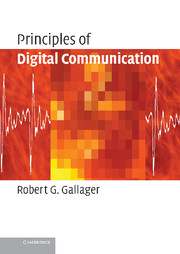Book contents
- Frontmatter
- Contents
- Preface
- Acknowledgements
- 1 Introduction to digital communication
- 2 Coding for discrete sources
- 3 Quantization
- 4 Source and channel waveforms
- 5 Vector spaces and signal space
- 6 Channels, modulation, and demodulation
- 7 Random processes and noise
- 8 Detection, coding, and decoding
- 9 Wireless digital communication
- References
- Index
4 - Source and channel waveforms
Published online by Cambridge University Press: 05 June 2012
- Frontmatter
- Contents
- Preface
- Acknowledgements
- 1 Introduction to digital communication
- 2 Coding for discrete sources
- 3 Quantization
- 4 Source and channel waveforms
- 5 Vector spaces and signal space
- 6 Channels, modulation, and demodulation
- 7 Random processes and noise
- 8 Detection, coding, and decoding
- 9 Wireless digital communication
- References
- Index
Summary
Introduction
This chapter has a dual objective. The first is to understand analog data compression, i.e. the compression of sources such as voice for which the output is an arbitrarily varying real- or complex-valued function of time; we denote such functions as waveforms. The second is to begin studying the waveforms that are typically transmitted at the input and received at the output of communication channels. The same set of mathematical tools is required for the understanding and representation of both source and channel waveforms; the development of these results is the central topic of this chapter.
These results about waveforms are standard topics in mathematical courses on analysis, real and complex variables, functional analysis, and linear algebra. They are stated here without the precision or generality of a good mathematics text, but with considerably more precision and interpretation than is found in most engineering texts.
Analog sources
The output of many analog sources (voice is the typical example) can be represented as a waveform, {u(t): ℝ → ℝ} or {u(t): ℝ → ℂ}. Often, as with voice, we are interested only in real waveforms, but the simple generalization to complex waveforms is essential for Fourier analysis and for baseband modeling of communication channels. Since a real-valued function can be viewed as a special case of a complex-valued function, the results for complex functions are also useful for real functions.
- Type
- Chapter
- Information
- Principles of Digital Communication , pp. 93 - 152Publisher: Cambridge University PressPrint publication year: 2008



